DataHub v3 Application Data Source and Connections
One of the features Logi DataHub v3 provides is the ability to connect to cloud- and application-based data. This topic presents examples of how to create connections to them when creating Dataviews.
- Creating an Application Data Source
- Application Source Details
- Amazon Dynamo DB
- Eloqua
- Financial Accounts (OFX)
- Google Analytics
- Marketo
- Microsoft Dynamics CRM on Premise
- Microsoft Dynamics CRM Online
- Microsoft Dynamics GP
- NetSuite
- OData
- QuickBooks on Premise
- QuickBooks Online
- QuickBooks POS
- Salesforce
- SAP Netweaver
- Managing Data Sources
Creating an Application Data Source
In Logi DataHub v3, a connection to data is called a "Source" and data can be retrieved from an application, a database, or a data file. In this topic, we'll explain how to create a new Source using an application.
In the Dataview Authoring tool, there are multiple paths to the Add Source panel, including:
- Sources menu option
 Create New Source.
Create New Source. - Dataviews menu option
 Create New Dataview
Create New Dataview  From Source tab
From Source tab Add New Source
Add New Source
The Add Source panel will appear; its controls will vary depending on the data provider chosen but the descriptions provided below are typical:
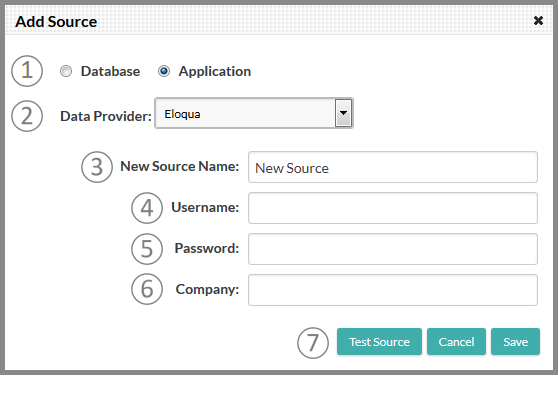
Select or provide the required information, as follows:
- Application - Select the Application radio button.
- Data Provider - Select the desired application. The panel controls will change with each selection.
- New Source Name - Give the Source an arbitrary name for easy recognition later.
- Username - Enter the user name required to access the application.
- Password - Enter the password required to access the application.
- Company - Enter any other information required by the target application.
- Test Source - This action will attempt to make the connection specified and provide a status message. In addition to indicating either success or failure, any existing Source with the exact same specifications will be identified so you can decide whether to use it instead or proceed to save your new Source.
Click Save to save your new Source. Repeat as necessary to create the Sources you need.
Application Source Details
This section provides the Source details, and helpful links, for each supported application.
Amazon Dynamo DB
The connection to Dynamo DB is made using your AccessKey, SecretKey, and optionally your Domain and Region. Your AccessKey and SecretKey can be obtained on the security credentials page for your Amazon Web Services account. Your Region will be displayed in the upper left-hand corner of the page when you are logged into Dynamo DB.
More information is available externally about the Amazon Dynamo DB provider.
Eloqua
The Add Source panel configuration details for Eloqua are shown in the example in the previous section.
Selecting Facebook as the data provider will result in the display of these controls:
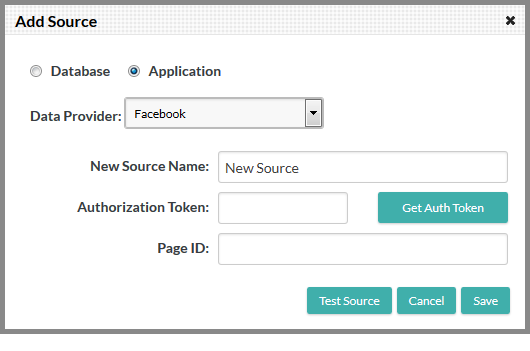
Click Get Auth Token to login to Facebook and copy your authorization token. You'll need to have Platform access turned on in Facebook to do this and you'll be prompted to enable it during this process if it's not.
The Page ID is the unique identifier of the Facebook page whose statistics you'd like to track. You may need to look it up via online tools or the page URL in Facebook. This web page explains how to find it, or a quick Google search for "Facebook Page ID" will lead you to several other sources.
Financial Accounts (OFX)
To specify a location for the database where the table, view, and stored procedures are located, set the Location property in the connection string. In addition you must also set the User and Password properties.
More information is available externally about the Financial Accounts (OFX) provider.
Google Analytics
Selecting Google Analytics as the data provider will result in the display of these controls:
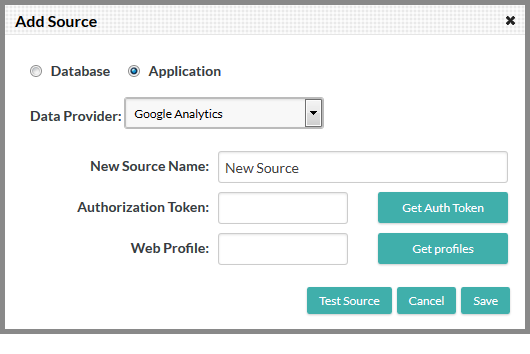
Click Get Auth Token and log into Google Analytics using your credentials. Copy and paste the token into the control provided.
Once you've provided a token, you'll need to select the Web Profile that will provide the data you are interested in. To do that, click Get Profiles to populate a list of web profiles and select one from the list.
Marketo
Selecting Marketo as the data provider will result in the display of these controls:
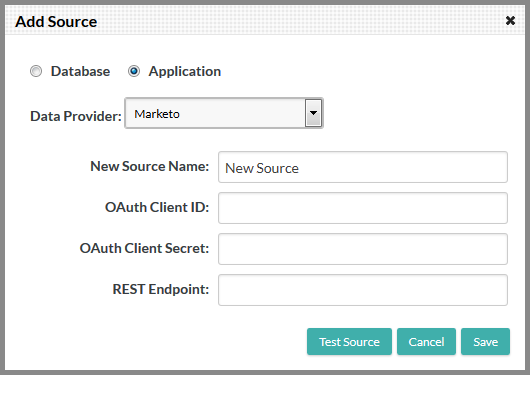
You'll need to enter User ID, Encryption Keyand SOAP Endpoint values in the controls provided in order to access to the data.
Microsoft Dynamics CRM on Premise
To specify a location to the database where the tables, views, and stored procedures are located, set the Location property in the connection string. In addition, you must set the User, Password, and Url properties.
Microsoft Dynamics CRM Online
Selecting Microsoft Dynamics CRM Online as the data provider will result in the display of these controls:
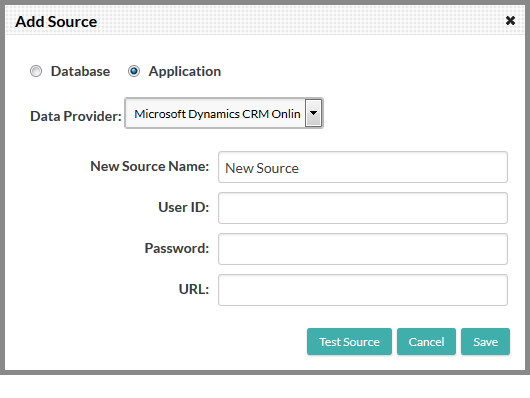
You'll need to enter the User ID and Password credentials that grant access to Microsoft Dynamics CRM Online. Enter the URL of the application that contains the data you want to work with.
Microsoft Dynamics GP
Selecting Microsoft Dynamics GP as the data provider will result in the display of these controls:
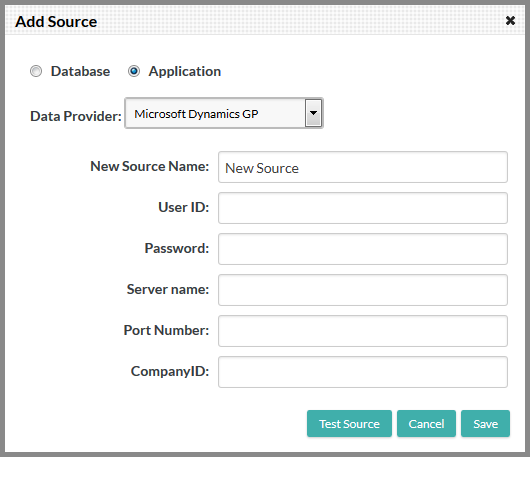
Supply the requested information in the proper controls.
More information is available externally about the Microsoft Dynamics GP provider.
NetSuite
To specify where the table, view, and stored procedures of the database are located, set the Location property in the connection string. In addition, you must also set the User, Password, and AccountId properties.
More information is available externally about the NetSuite provider.
OData
You must set the User and Password properties in the URL.
More information is available externally about the OData provider.
QuickBooks on Premise
To specify a location to the database where the tables, views, and stored procedures are located, set the Location property in the connection string. In addition, if QuickBooks is not installed on the local machine and you're using the QuickBooks Remote Connector, you must set the User, Password, and URL properties.
More information is available externally about the QuickBooks on Premise provider.
QuickBooks Online
Selecting QuickBooks Online as the data provider will result in the display of these controls:
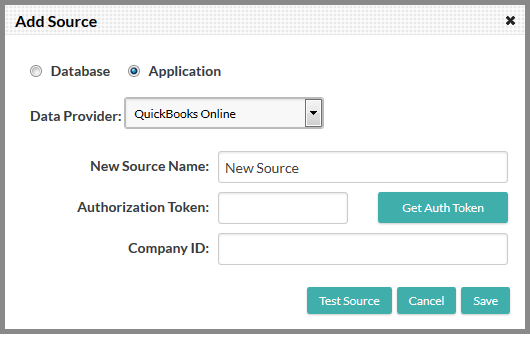
You'll need to provide an Authorization Token. Click Get Auth Token and log into QuickBooks Online using your credentials. Copy and paste your authorization token into the control provided. Enter the Company ID for the organization that contains the data you want to use.
More information is available externally about the QuickBooks Online provider.
QuickBooks POS
Specify the User ID, Password, and URL required to access the data.
More information is available externally about the QuickBooks POS provider.
Salesforce
Selecting Salesforce as the data provider will result in the display of these controls:
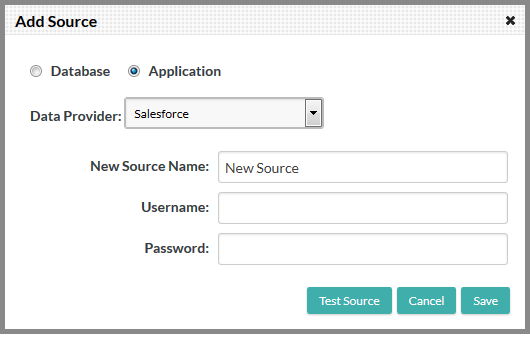
Enter the Username and Password for the Salesforce account whose data you want to use.
SAP Netweaver
To specify a location to the database where the tables, views and stored procedures are located, set the Location property in the connection string. In most cases, you'll also need to set the User, Password, ConnectionType, Client, and SystemNumber properties.
More information is available externally about the SAP Netweaver provider.
Selecting Twitter as the data provider will result in the display of these controls:

You'll need to provide an Authorization Token. Click Get Auth Token and log into Twitter using your credentials. Copy and paste the authorization token into the control provided.
Managing Data Sources
As you create Sources, they're represented in the Sources page with graphic "pills":
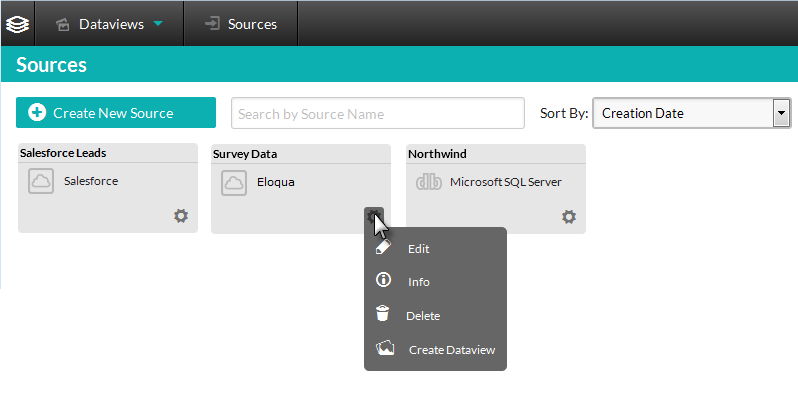
Each pill displays the Source name and application type, as shown above, and includes a "gear" icon. Hovering your mouse cursor over the icon displays a menu of management actions.
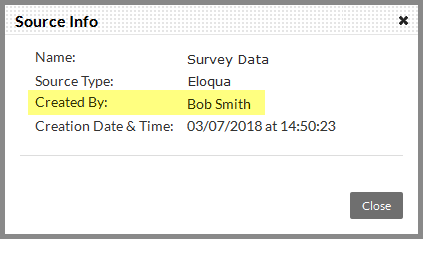
The Info menu option allows you to see, among other details, who created the Source, as shown above. This can be helpful if the Source has been shared with you by another user. The Delete option will only be included if you're the user who created the Source.
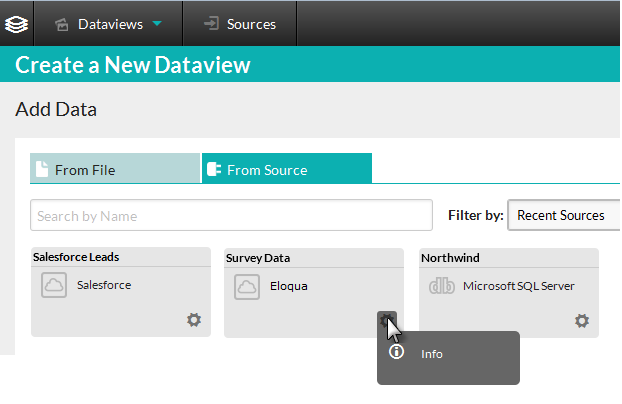
Source pills are also visible in the Create a New Dataview page, under the From Source tab, as shown above. The gear icon, however, only displays an information option from this page.